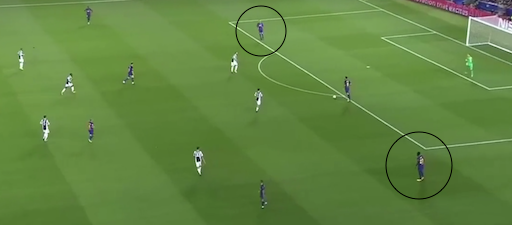WORLD CLASS COACHING
Build Up From the Back - A Tactical Analysis
By Luca Bertolini
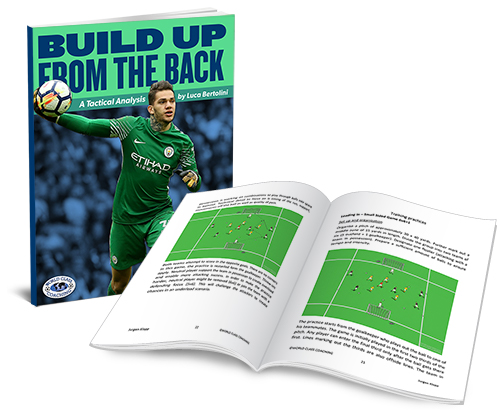
Table of Contents
PART THREE
Player and Team Positions (Inc GK) to Best Build From the Back
The La Volpe Exit
Player and Team Positions (Inc GK) to Best Build From the Back
1-4-3-3
The team shape is basically structured with a classic 4 at the back, 3 midfielders with a lower vertex and 2 wider teammates, 3 forwards, of which one center striker and two wider advanced wingers.
The players are placed inside the spaces and half spaces, commonly recognized in all the tactical analysis by now.
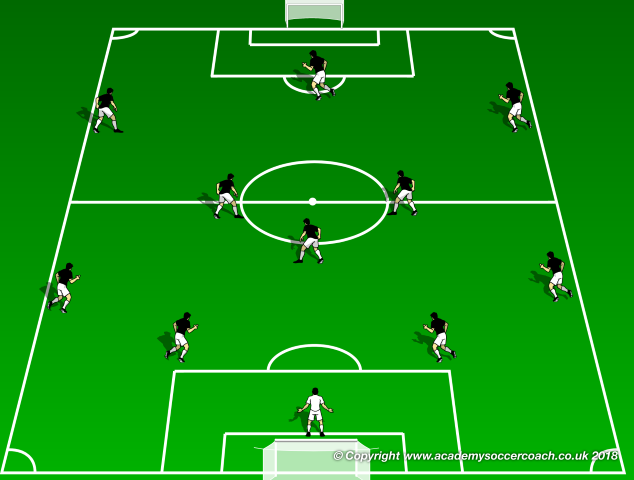
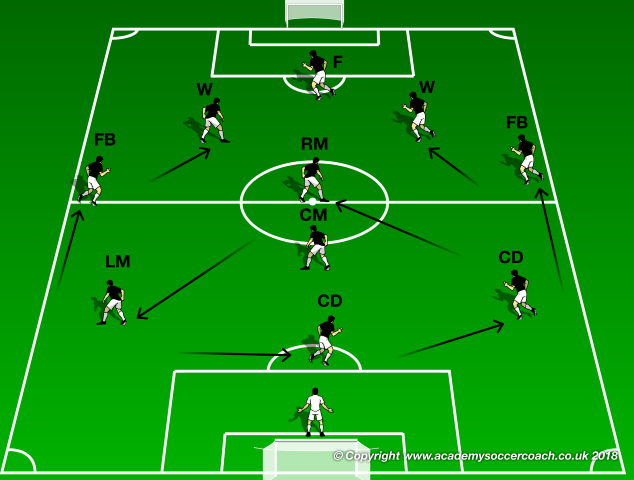
Whoever is the first receiver of the goalkeeper pass (the receiver is likely the center defender on the right, who is supposed to be the most skilled player in this example), this could be a first possible rotation to re-shape the team on the field and to progress forward.
• The center defenders shift toward the right side (or the left)
• The right and left fullbacks run forward to play as wingers
• The center midfielder becomes a balance player
• The right midfielder runs forward as advanced player to shape a rhombus
• The opposite midfielder drops back to cover the space and to shape a line of 3 at the back
• The wingers run inside to support the forward and to create space on the flanks
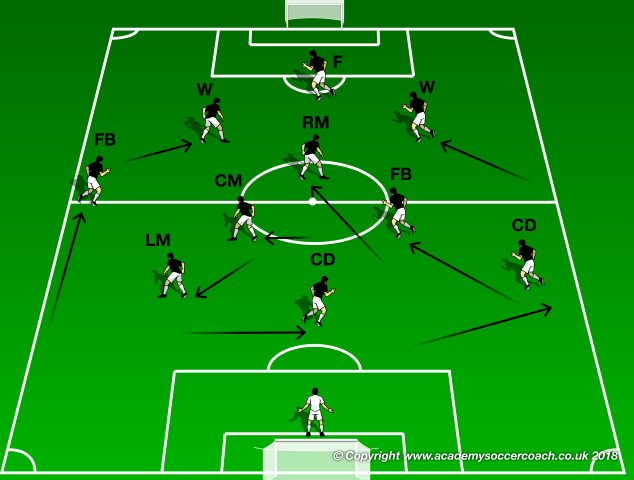
Whoever is the first receiver of the goalkeeper pass (the receiver is likely the center defender on the right, who is supposed to be the most skilled player in this example, or even the dropping back midfielder), this could be another possible rotation to re-shape the team on the field and to progress forward.
• The center defenders shift toward the right side (or the left)
• The right fullback runs toward the middle to overload the center as inverted fullback
• The left fullback runs forward to play as winger
• The center midfielder moves toward the left to give a couple of middle players
• The right midfielder runs forward as advanced player to form an advanced rhombus
• The opposite midfielder drops back to cover the space and to form a line of 3 at the back
• The wingers run inside to support the forward and to create space on the flank
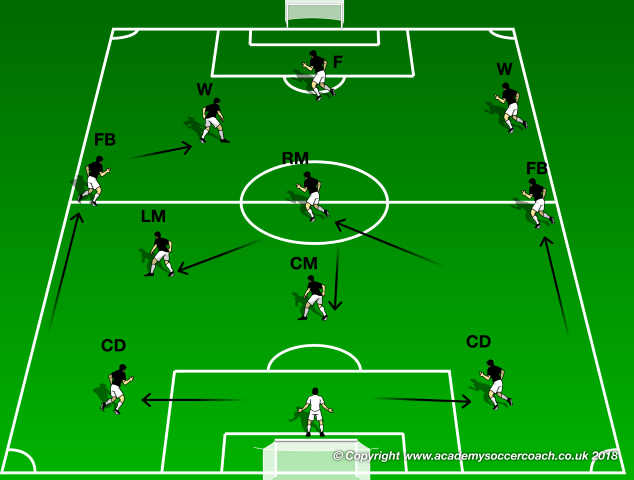
This third example is very close to the "La Volpe Exit,” with few, but important different concepts, as the main objective is to overload one side while building up, creating a weak side in the opposition defense, where the opposite winger and fullback can exploit the space.
• The center defenders run toward wider positions just out of the penalty area
• The goalkeeper is the third active player who supports the building up phase
• The center midfielder drops back in a balance position, not between the defenders, but in front of them to be an option
• The right midfielder shifts across and the left one drops back a little toward the flank
• Both the fullbacks run forward
• The winger of the strong side runs inside to overload the center
• The winger on the supposed opposition weak side stays wide
• The forward must attack the goal
1-4-2-3-1
The team shape is basically structured with a classic 4 at the back, 2 center midfielders who start on the same line, 3 advanced players behind 1 forward.
The players are placed inside the spaces and the half spaces, commonly recognized in all the tactical analysis by now.
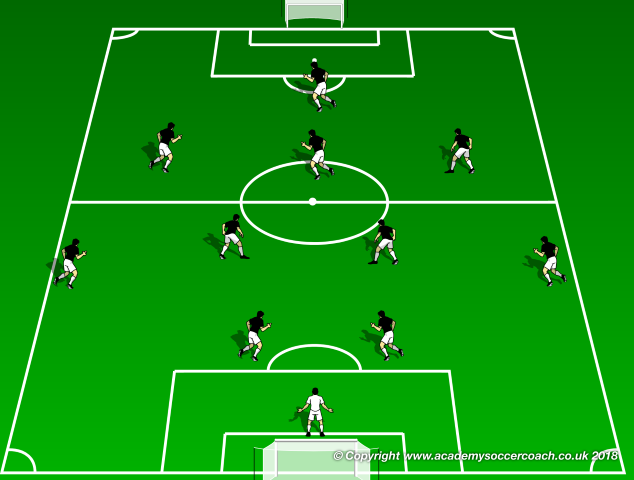
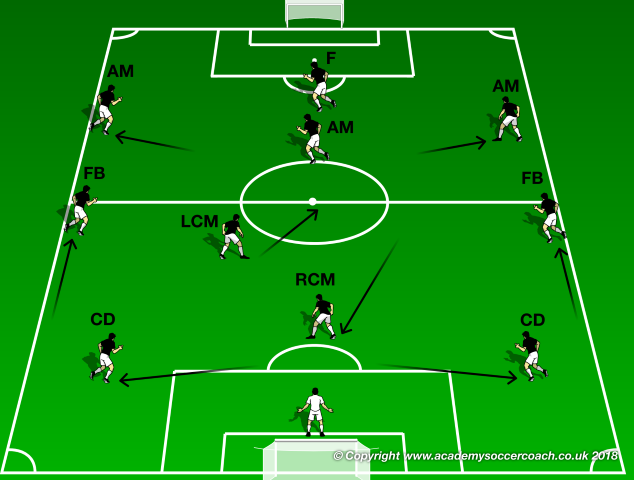
This is a first example, where a 1-3-3-3-1 formation is developed on the field and it recalls to our mind the Bielsa building from the back idea; further on some pictures of this kind, looking at the formations of Bielsa's Athletic Bilbao and Lille will be analyzed.
• The center defenders run wide to stay positioned between the penalty area and the sidelines
• One of the center midfielders drops back as lower vertex and the other one runs forward as upper vertex; two lines of 3 are now formed
• The fullbacks run forward to play as outer midfielders, forming another line of three in the middle third, together with the midfielder, who moved forward
• The outer advanced midfielder moves wide to have the chance to play combinations with the fullbacks
• The center advanced midfielder and the forward stay placed in the center of the final third to finish, but they don't have to be on the same line; the second forward forms another line of 3, with the outer teammates
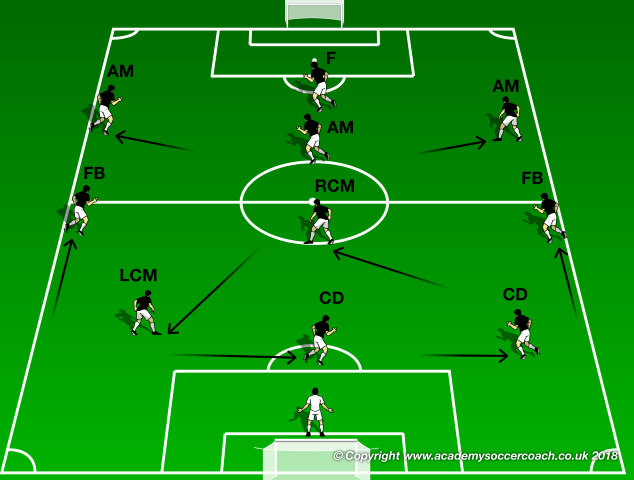
This is a further example to shape a 1-3-3-3-1 formation to recall to our mind the Bielsa building up from the back idea on the field again.
• The center defenders move wide on the right (or on the left)
• The center midfielder of the side where the center defender moved runs inside to play as center midfielder
• The opposite center midfielder drops back to cover the space, forming a back line of 3
• The fullbacks run forward to play as outer midfielders, forming another line of three in the middle third, together with the midfielder, who moved forward
• The outer advanced midfielder moves wide to have the chance to play combinations with the fullback
• The center advanced midfielder and the forward stay placed in the center of the final third to finish, but they don't have to be on the same line; the second forward forms another line of 3 with the outer teammates.
1-3-5-2
The three-man back line hasn’t returned because it never truly went away. It is always in use by one team or another, always an option in emergency.
As we will analyze further on in this book, in the progression of La Salida Lavolpiana, the defensive midfielder drops between the center backs, who move into the channels to start the build-up phase and the fullbacks then move further to play as wingers. These exchanges of positions are the fundamentals of the "Juegos de Posicion" and of the occupation of the well-known 5 vertical columns of the pitch.
The position games are built around playing against a 1-4-4-2-defense shape, the most common defense shape. This way a 3 v 2 duel is created at the back, and then a 5 v 4 inside the first third; the numerical advantage is not the only a benefit, as the pitch is made wider to defend for the opposition.
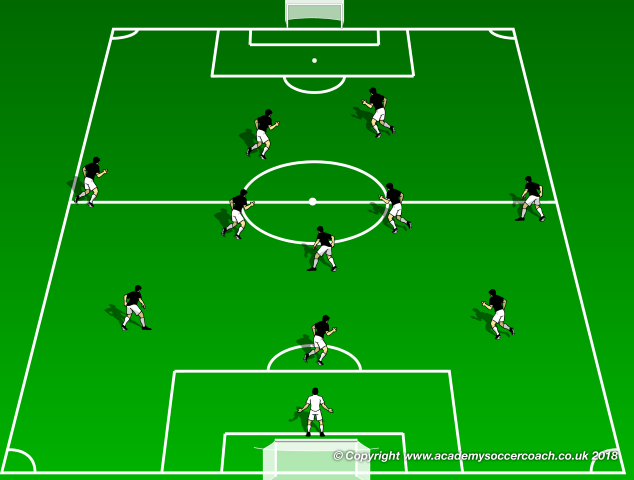
The permanent back 3 was inevitable, following the rise of the building up situations. A good player at playing in both defensive midfield and center back positions is required. The fullbacks must be tasked as wingbacks and to be more technically skilled players. Many wingers are now ‘inverted’ and they adapt well to being placed more permanently in the channels.
The center backs increased their technical skills and with the fixed 3 at the back, they can push into midfield, as they can be relied upon to play quality passes and to carry the ball up into midfield or out wide. The back 3 is a safer way to defend and to press high as three forwards can equalize the initial numerical disadvantage against the opposition defense.
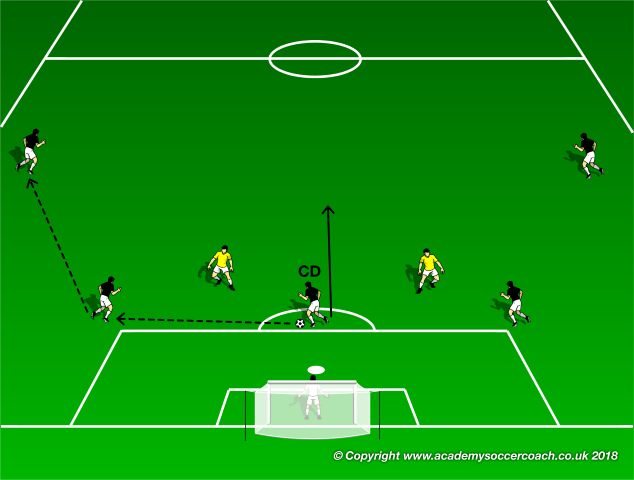
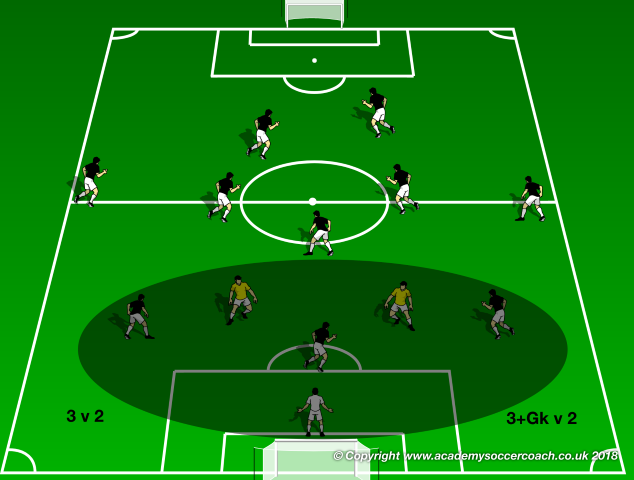
The starting duel is a 3 v 2 in front of goal: center defender, left center back and right center back against opposition forward. The goalkeeper can be used as link or support player, creating a 4 v 2 duel. The numerical advantage is then sure since the beginning, without any previous player rotation.
If the team is able to overcome the first line of pressure, 7 players can build up play in the middle third and try to finish against 8 opponents. An attacking move, which starts with equal number of players or with a little numerical disadvantage, can be dangerous, moving the ball from a strong side to the opponent's weak one.
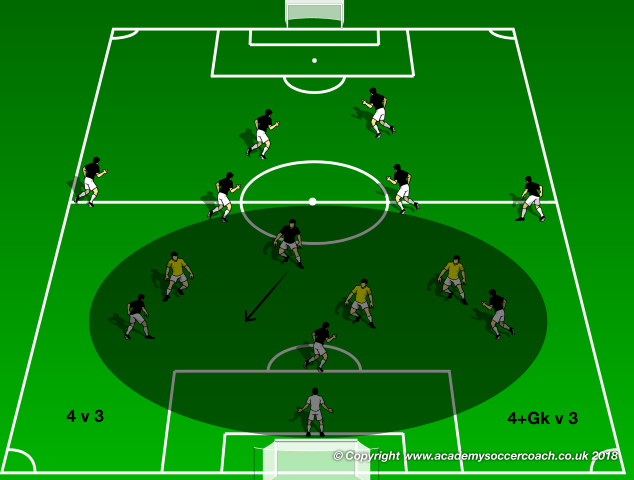
If the opposition puts pressure with 3 forwards in the first third of the team in possession, the center defender, the left center back and the right center back together with the goalkeeper, ensure a 4 v 3 numerical advantage. One midfielder can drop back or open a passing lane to create a position game 5 (4+1) v 3 to progress on the pitch.
If the team is able to overcome the first line of pressure, 7 or 6 players can build up the play in the middle third and try to finish against 7 opponents, keeping the team balanced on the field.
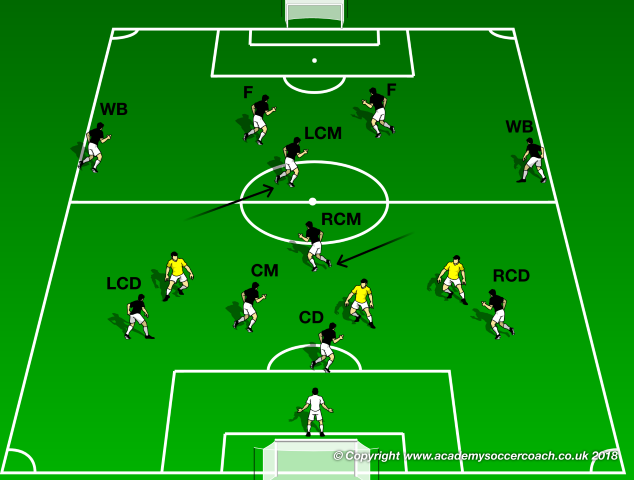
If the wingbacks run up the field, one center midfielder must help the defense line, saving it or also dropping back; the other one can support the attacking move behind the forwards. A group of 5 players can now try to finish and score.
La Salida Lavolpiana - The La Volpe Exit
This term describes the most common way of building up from the back, a concept that is used by the Argentine coach Ricardo La Volpe and that requires a player who drops back into defense line, to create a numerical advantage against the first line of the opponent.
The goalkeeper usually has possession and if a team plays with two center backs and against two forwards, then the center backs split out wide and a midfielder drops back in between them to create a 3 v 2 situation against the forwards. It’s actually a 4 v 2 when including the goalkeeper. This line is also a defense line in case of loss of possession, but the main idea is to always have an extra player to help the progression from the first line of the formation into the second one. The dropping midfielder creates this numerical advantage to play a 3 v 2, using again the goalkeeper if the ball can't be moved forward.
The fullbacks are positioned up and wide to receive and to create numerical advantage in the middle third, and a strong side as well, together with the midfielders and a forward who is dropping back from the final third.
Pep Guardiola is possibly the most known advocate of La Salida Lavolpiana and made the concept famous with his Barcelona 2008-2012.
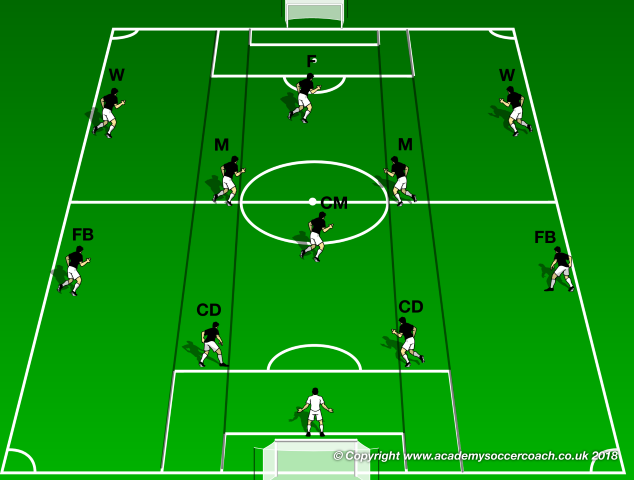
4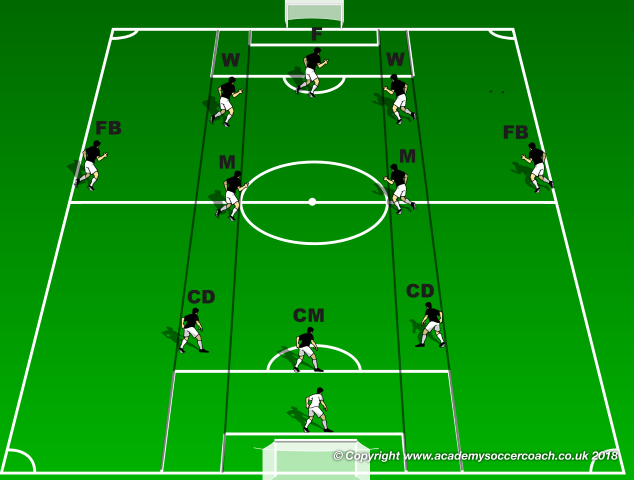
La Volpe created it as a useful way to build up from the goalkeeper, but nowadays it is common pattern of play whoever is the player in possession.
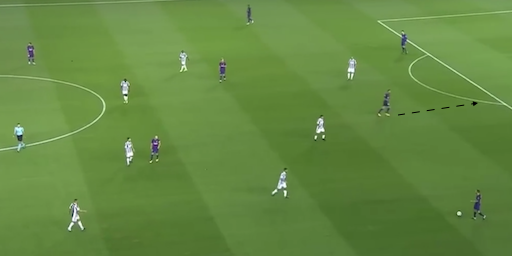
Here is the concept in practice; Sergio Busquets drops in between the two center backs to create multiple 4 v 2 duels against Juventus’ strikers, to help progress the play. The duel can be found as 3+gk against the forwards, or the back line of four against the forwards, or a duel with two center Barcelona players (Busquets and Pique) and two midfielders (Iniesta and Rakitic) against two forwards in the middle.
Rondos and position games are so recurrent here.
